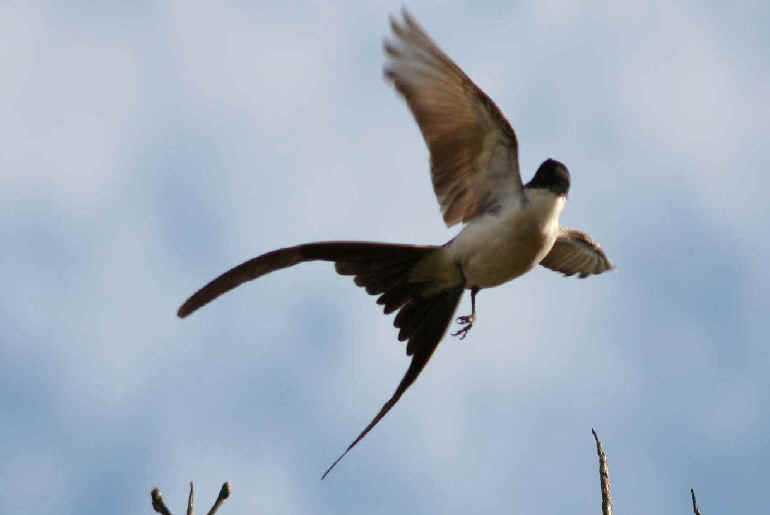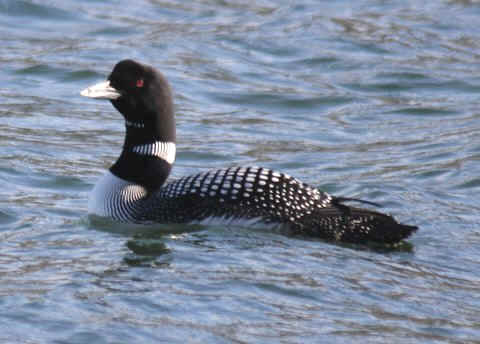The BIRDLINE and NATURELINE by ARMAS HILL
With Birds
on Far-flung Islands, others on New York lakes
Armas Hill has presented the "Birdline", originally from
Philadelphia, on the phone and internet for over 3 decades, and on the radio
in Delaware for about 10 years.
Links:
A
List & Photo Gallery of North American Birds, in 6 Parts
A
List & Photo Gallery of North American Mammals
A Chronological
List of Upcoming FONT Tours Other
Birdlines/Naturelines

Photos here of two
species referred to in this September 24, 2012 edition of the Birdline/Natureline:

Above: a Fork-tailed
Flycatcher
Below: a Common Loon, or Great Northern Diver
Both birds in this Birdline are referred to in New York.
Both photographs here during Focus On Nature Tours,
the flycatcher in Brazil, the loon in Iceland.
i

The
Birdline & Natureline for September 24, 2012:
This time
including: Adirondack Loons, British Splits, Canadian
Shrikes and Sparrows, and More
Islands referred to here, with some more far-flung than
others, include:
Long Island, New York
Sable Island, Nova Scotia, Canada,
Iceland,
the Azores, Berlangas, Madiera, Selvagens, Canary, and Cape
Verde Islands in the North Atlantic,
the Hawaiian and Midway Islands in the North
Pacific,
the Cabrera archipelago, the Balearic Islands,
and Corsica and Sardinia in the Mediterranean,
and the Senkaku Islands between Japan & China in
the East China Sea.
Let's begin our series of reports on Long Island,
New York where a FORK-TAILED FLYCATCHER was seen on
September 19, just that day, in Nassau County at the Oceanside
Marine Nature Study Area. It was seen by multiple observers
before it smartly left when a COOPER'S HAWK came on the
scene. It was an adult male with a long tail.
Such a FORK-TAILED FLYCATCHER would be an
"overshoot" of a South American bird, going the
"wrong way" north instead of south. During the
Austral summer, the species nests in southern South
America.
In the Austral winter, they normally go north to places
such as Venezuela and Trinidad.
The FORK-TAILED FLYCATCHER in New York last week was with an
EASTERN KINGBIRD or two. Both species are in the same genus,
TYRANNUS.
Also in that genus, and also on Long Island this past week
were 2 WESTERN KINGBIRDS on September 16 at the Robert Moses
Park.
Going from the North American Atlantic coast to off the
Pacific coast, a HAWAIIAN PETREL was seen offshore from Bodega
Bay, California, on September 21. That bird, as its
name implies, came from where it nests in the Hawaiian
Islands.
Back in eastern North America, a bird not often seen in that
part of the world is the FRANKLIN'S GULL. But 5 of them were
seen together in Pennsylvania on September 22 only in
Mercer County in the western part of the state.
Further east in PA, the next day, 1 FRANKLIN'S GULL was in
Lancaster County, on an island in the Susquehanna River
at the Conejohela Flats.
RUFOUS HUMMINGBIRDS from western North America have begun to
appear in the eastern US.
In Pennsylvania, in Walnutport, apparently a bird that
was banded there last year has returned.
Another one seems to be slightly to the south in Lehigh
County, Pennsylvania.
And further south, in Delaware, one has appeared in
Lincoln.
In northern New Jersey, at the Montclair Hawk Watch, on
Saturday, September 22, between 4 and 6pm, there was a
massive movement of migratory MONARCH BUTTERFLIES. They were
"everywhere", with an estimate of up to 5,000.
The Montclair Hawk Watch is said to be the second oldest
regularly-staffed hawk watch in the US, and there has never
been anything there like the mass of butterflies late that
afternoon.
At another northern New Jersey hawk watch, at Chimney Rocks,
7,154 BROAD-WINGED HAWKS were tallied on September 16. This
morning, September 24, at Chimney Rock, between 9:30
& 11:30, "many hundreds" more were passing
overhead.
From Chimney Rocks to CHIMNEY SWIFTS: This morning, in
the city of Pittsburgh, Pennsylvania, at about 8:45,
there were "hundreds and hundreds" circling
overhead.
Earlier this month, the British Ornithologists Union
(the BOU) "split" the CORY'S SHEARWATER into
3 species:
- the CORY'S SHEARWATER, Calonectris borealis, breeding
on north Atlantic islands, in the Azores, Madeira, and
the Canary Islands, going, when not breeding, into the
western Atlantic Ocean
- the SCOPOLI'S SHEARWATER, Calonectris diomedea, breeding
in the Mediterranean Sea, going, when not breeding,
into the Atlantic Ocean
- the CAPE VERDE SHEARWATER, Calonectris edwardsii
(the last of these was already recognized by the American
Ornithologists Union, the AOU, in 2006)
In the field, the SCOPOLI'S SHEARWATER can appear appreciably
smaller billed than the CORY'S SHEARWATER.
However, it must be noted that both the CORY'S SHEARWATER and
the SCOPOLI'S SHEARWATER have marked sexual dimorphism, so
that a small female CORY'S SHEARWATER can overlap in bill-size
with a male SCOPOLI'S SHEARWATER.
But, because the SCOPOLI'S SHEARWATER has a smaller head, its
bill can look large.
The CORY'S SHEARWATER has been said to be the largest
shearwater. The wingspan of the CORY'S SHEARWATER is from 113
to 124 cm. That of the SCOPOLI'S SHEARWATER is from 110 to 121
cm.
Under similar conditions, the flight of the SCOPOLI'S
SHEARWATER is lighter and less lumbering than that of the CORY'S
SHEARWATER, with somewhat quicker wingbeats.
Off North America, the SCOPOLI'S SHEARWATER is said to
occur as an uncommon to rare nonbreeding visitor, mostly from
May to October, in warmer waters from Florida north to New
England, and in the Gulf of Mexico.
It likely occurs in the North American range of the CORY'S
SHEARWATER that is much more numerous.
Continuing with the recent taxonomic changes by the BOU, the
British Ornithologists Union:
This month, they "split" the BAND-RUMPED STORM
PETREL into 3 species:
- the MADEIRAN STORM PETREL, Oceanodroma castro, breeding in
the summer, from June to October, on the Madeira
archipelago and the northeastern Canary Islands
- the CAPE VERDE STORM PETREL, Oceanodroma jabejabe, breeding
on the Cape Verde Islands, little known but said to
have 2 genetically distinct populations
- the MONTEIROS STORM PETREL, Oceanodroma monteioroi, breeding
on the Azores Islands, described formally in 2008
From the recently-published book, "Petrels,
Albatrosses, & Storm-Petrels of North America, A
Photographic Guide", by Steve Howell, the following:
Recent studies have found considerable diversity within the
BAND-RUMPED STORM-PETREL COMPLEX, with at least 9 distinct
populations, with at least 5 in the Atlantic Ocean and 4 in
the Pacific Ocean.
Several, maybe all, of these populations are distinct enough
to be recognized as species. Identification at sea however can
still be described as problematic.
Another North Atlantic population, breeding in the winter,
that has been called the "GRANT'S STORM-PETREL" has
yet to be described. It nests from October to March in the
eastern North Atlantic islands of the Azores, Berlangas,
the Canary Islands, the Madeiran archipelago,
and the Selvagens.
The "GRANT'S STROM PETREL" has certainly been found
in oceanic waters offshore from eastern North America. The
wing molt schedule of most Gulf Stream and Gulf of Mexico
birds is consistent with GRANT'S. It ranges at sea mainly from
May to August in warm waters of the western Atlantic and Gulf
of Mexico.
Other populations of what has been the BAND-RUMPED
STORM-PETREL may well occur off eastern North America
including the MADEIRAN STORM-PETREL, which may be an
uncommon to rare non-breeding visitor to the Gulf Stream off
North Carolina and maybe elsewhere, probably from May to
August.
Other recent BOU taxonomic changes include:
The splitting of the SOMALI COURSER, Cursorius somalensis,
from the CREAM-COLORED COURSER, Cursorius cursor.
We've seen the CREAM-COLORED COURSER (a nice bird!)
during FONT tours in the Canary Islands.
I'm not sure I know anyone who's seen a SOMALI COURSER.
From the ARCTIC WARBLER, Phylloscopus borealis, that occurs in
Alaska, two splits:
1) the KAMCHATKA LEAF WARBLER, Phyllopscopus examinandus, and
2) the JAPANESE LEAF WARBLER, Phyllopscopus xanthodryas
Both of these "new species" have been seen during
FONT tours in Japan.
In the area of the western Mediterranean, the MARMORA'S
WARBLER has been split to:
1) the BALEARIC WARBLER, Sylvia balearica, on the Balearic
Islands, and
2) the MARMORA'S WARBLER, Sylvia sarda, on Corsica, Sardinia,
and in southern France
In the EURASIAN NUTHATCH there has been a "split".
With the new SIBERIAN NUTHATCH, Sitta arctica.
A new subspecies has been created for the EUROPEAN
STORM-PETREL, Hydrobates pelagicus.
It is: the "MEDITERRANEAN STORM-PETREL", breeding
on the Cabrera archipelago of the Balearic Islands off
northeastern Spain.
And, lastly, here, the BOU has put the RUFF, the BUFF-BREASTED
SANDPIPER, and the BROAD-BILLED SANDPIPER into the genus CALIDRIS.
These 3 species have had their own unique genera.
We've referred to the Canary Islands. During a recent
2-day pelagic trip, September 15-16, birds referred to, the
CORY'S SHEARWATER, and the MADEIRAN STORM-PETREL were seen, as
was a single, distant SWINHOE'S STORM-PETREL.
The trip went 60 miles north from the island in the eastern
Canaries known as Lanzarote.
We've referred to British changes in bird taxonomy.
Relating to particular birds, the British refer to LOONS as
DIVERS. They have for a long time, and will continue.
What is called in North America the COMMON LOON, is
called in Britain the GREAT NORTHERN DIVER.
The GREAT NORTHERN DIVER does not nest in Europe, other
than in Iceland. Some do go to the British coast in
winter.
The COMMON LOON does nest in northern North America,
including on lakes in the Adirondack Mountains of
New York State.
An extensive study has just been completed in that region of
the LOON POPULATION, revealing that mercury contamination can
lead to a population decline.
The research effort was a joint project between the New York
State Energy Research & Development Authority, the
Biodiversity Research Institute, and the Wildlife Conservation
Society.
For about 10 years researchers from those organizations,
followed mercury contamination through the aquatic food chain,
from zooplanton to the COMMON LOON, at lakes such as
Cranberry and Lows.
They found that LOONS with elevated mercury levels produce
fewer chicks, particularly those that breed on the more acidic
lakes common in the Adirondack Park.
In 2003 & 2004, the researchers collected samples from 44
lakes in that area testing for mercury. As LOONS are
long-lived (20 to 30 years), territorial, and at the top of
the aquatic food web, they are excellent sentinals of the
health of the habitat.
From 1999 to 2007, biologists captured the hard-to-catch
LOONS, banded them, and took samples and analyzed the mercury
content. Just over 100 LOONS were sampled, and more than half
had blood mercury concentrations that were above the risk
threshold.
LOONS only raise 1 or 2 chicks per year, so even a small
difference in their reproductive success can cause a
major problem for the population, in the Adirondacks and
elsewhere as well.
But some good news: In December 2011, the U.S. Environmental
Protection Agency finalized the Mercury and Air Toxics
Standards Rule which, for the first time, regulates how
much mercury can be released into the environment by
coal-fired power plants. this should help human health, and
also the ecological health of the Adirondack Park, and
especially that of the LOONS.
North of New York, in Ontario, Canada, there is a
critically endangered population of LOGGERHEAD SHRIKES
that nest there in the summer.
Some SHRIKES from that area have been color-banded. Some
have not.
Just over a week ago, a banded LOGGERHEAD SHRIKE was found
in the US state of Virginia, at the Occoquan National
Wildlife Refuge.
From the band, it was determined that it was a captive-raised
bird that was hatched in Ontario this summer, and
released on August 15, at Napanee northwest of Kingston,
Ontario.
Earlier in September, an umarked LOGGERHEAD SHRIKE was
photographed in Chatham, Massachusetts. From the photo,
it was determined to be a hatch-year bird, probably from
Canada.
If anywhere in the East, you happen to find a LOGGERHEAD
SHRIKE, please check for a band, and photograph if you can.
Submit to Jessica Steiner at: jessica@wildlifepreservation.ca
On Sable Island, off the coast of Nova Scotia, a
unique subspecies of the SAVANNAH SPARROW nests in the summer,
only on that island, the IPSWICH SPARROW.
They leave Sable Island to spend the winter along the
Atlantic coast as far south as Florida.
Last month, a number of IPSWICH SPARROWS were banded,
with unique color-coded leg bands.
If later this year, you happen to see such a bird, please
check for the band, and photograph if you can.
Submit to Zoe Crysler at: zcrysler@gmail.com
Also you can check for more info, the site: http://sableislandgulls.wordpress.com/
You may have heard in the news lately about the tension
between China and Japan relating to some
uninhabited islands in the East China Sea.
They are the Senkaku Islands (in Japanese) or the
Diaoyu Islands (in Chinese), translated into English, the Pinnacle
Islands.
They are located 200 nautical miles east of the mainland
of China, 200 nautical miles southwest of the Japanese
island of Okinawa, and about 120 nautical miles
northeast of Taiwan.
They are uninhabited by people, yes, but they are inhabited
by birds, and what you may or may not know is that the
islands are one of the very few breeding sites of the rare
SHORT-TAILED ALBATROSS, a species that was thought to be extinct
about 1950.
The SHORT-TAILED ALBATROSS has, through the centuries, only nested
at 2 places in Japan: the island of Torishima and
the Senkaku Islands.
The story of the decimation of the ALBATROSSES at
Torishima is well known. From the end of the 19th Century,
they were slaughtered for their feathers.
There had been many, but by 1949 a research team on the island found
none. None. However, 2 years later, about 30 appeared. They
had been young birds wandering the out over the ocean for
years. The species had a second chance.
by 1990, the population at Torishima Island had grown to about
1,200. In 2010, about 2,570 were there.
The story at the Senkaku Islands was, historically, a
similar sad story of decline and disappearance, with later,
recovery, but the number of birds now at the Senkakus is
not as large as at Torishima.
But, as at Torishima, they were slaughtered.
In 1884, it was said that "the Senkakus were so awash
with ALBATROSSES that there was almost no room to set foot
ashore".
In 1895, after victory in the Sino-Japanese War, japan
officially claimed sovereignty over the Senkaku Islands.
That same year, the Japanese government allowed a man named
Tatsushiro Koga to "develop" the island and for he
and his men to collect feathers of the "AHO-DORI",
the SHORT-TAILED ALBATROSS.
In 1897, they killed 160,000 of the birds, dramatically
slashing the population.
In 1900, only some small flocks could be found,
containing just 20 to 30 birds. In the years that followed,
with the birds gone, the business on the island changed
for a while to guano mining, and then to tuna fishing in
nearby waters. By 1940, people had left the islands, and not a
single ALBATROSS was to be found there. As late as 1963,
searches there found none.
In the late 1960s, the possibility of oil and natural gas
reserves under the seabed around the islands was announced,
and shortly after that the issue of territorial rights for the
area between Japan, China, and Taiwan began, and, as you know
from the news, has continued.
But during the second half of the 20th Century, the population of
the SHORT-TAILED ALBATROSS has been recovering. And now, it
is again a breeding bird in the Senkaku Islands,
particularly on Minami Kojima.
Also on the Senkaku Islands, on Uotsuri Jima, an
endemic mammal has been found, the SENKAKU MOLE, Mogera
uchidai.
Also, regarding the history the SHORT-TAILED ALBATROSS in
Japan it should be noted that:
In 1958, the Japanese government declared the bird to be
"a special bird of protection".
In 1962, the bird became a "Special National
Monument".
In 1993, with the "Act for the Conservation of
Endangered Species of Wild Fauna and Flora", the AHO-DORI,
or SHORT-TAILED ALBATROSS was designated by Japan as one of
the "National Rare Species of Wild Animals",
and was therefore always to be protected.
Regarding the history of the Senkaku Islands, it might
also be noted that:
From 1945 to 1972, the United States administered the islands
before returning them to Japanese control under the Okinawa
Reversion Treaty between the U.S. and Japan.
Here, a final note regarding the SHORT-TAILED ALBATROSS on
another island, Midway Island, in the central Pacific
Ocean:
In June of this year, on Midway, SHORT-TAILED ALBATROSSES successfully
fledged a second chick, breeding for the second consecutive
year.
The pair of parents were a 9 year-old female and a 25 year-old
male, both of which came from Torishima Island in Japan.
The nesting in June 2012 was only the second known successful
breeding by the SHORT-TAILED ALBATROSS away from the two Japanese
island locations that have been mentioned earlier here.
If you'd like to read more about Rare Birds in Japan,
such as the SHORT-TAILED ALBATROSS, please click the link
below:
http://www.focusonnature.com/BirdListRareBirdsJapan.htm
For information about upcoming FONT tours, at various
places, including new ones in Estonia & Ecuador,
and those in Brazil, please click:
www.focusonnature.com
The Birdline (and the Natureline) are affiliates
of Focus On Nature Tours.
Armas Hill has presented the Birdline, originally from
Philadelphia, on the phone and the internet for over 3
decades, and on the radio in Delaware for 10 years.
For an archive of some previous Birdlines & Naturelines:
To
Top of Page



